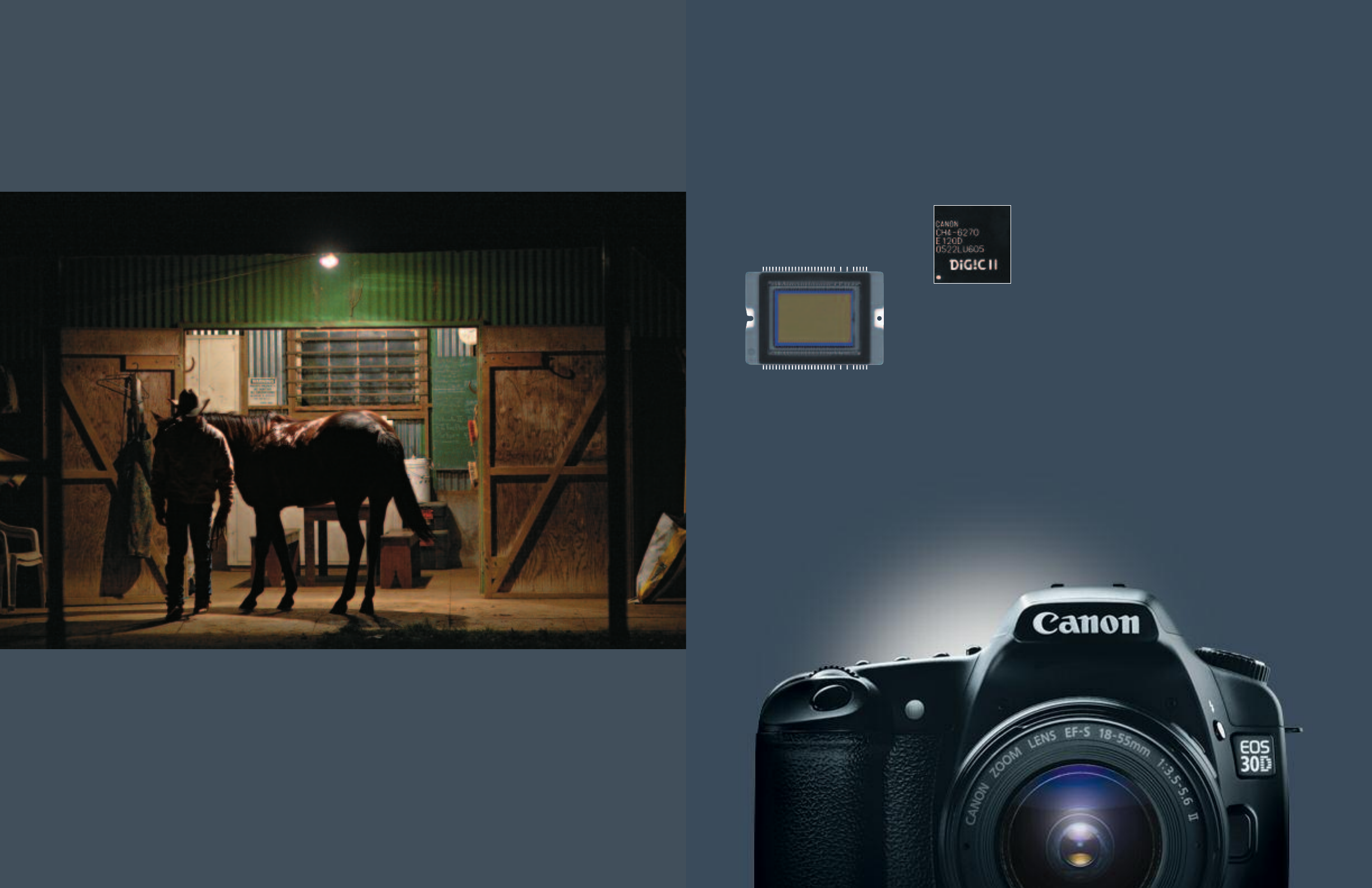
8.2-Megapixel Canon CMOS Sensor
C
anon's
8
.2-megapixel CMOS sensor
c
aptures
images with exceptional clarity and tonal range.
With an incredibly wide dynamic range, the
EOS 30D captures a tremendous breadth of
high
light and shadow detail and has been
refined to accommodate the EOS 30D’s
extended ISO range. The advantage of Canon’s
CMOS sensor is significant: images are captured
with silky-smooth resolution, stunning detail
and sharpness. Long exposures and other
shooting situations that generally produce
digital noise are kept in check through the
EOS 30D’s enhanced noise reduction algorithms,
eliminating graininess and ensuring that every
image is clear. This second-generation, single
plate
APS-C size sensor (22.5 x 15.0mm) has the
same
3:2 ratio as film cameras, enabling an
effective angle of view that is
1.6x the normal
EF lens focal length.
DIGIC II Image Processor
T
he driving force behind
the EOS 30D’s CMOS
sensor is Canon’s
exclusive
≥
II
Image
Processor
, which has been
enhanced for across-the-
board improvements in
processing speed, image quality and color
rendition. The DIGIC II processes and converts
light information captured by the CMOS sensor
into images of exceptional clarity and resolution.
Phot
ogr
aphers can expect precise, natural colors
and spot-on white balance in any number of
lighting situations. Through sophisticated signal
pr
ocessing algorithms, the DIGIC II Image
Processor in the 30D accelerates all aspects
of image capture and consumes less battery
power than its predecessor, the EOS 20D.
Extensive ISO Range
The EOS 30D has an extensive ISO range from
100 to 1600 plus ISO 3200 (H) in extended
mode. ISO values are selectable in 1/3-stop
increments and are not only displayed on the
camera’s top display, but also in the viewfinder.
The 30D’s CMOS sensor features a set of narrow-
gap microlenses and noise reduction circuits to
improve performance at
high ISO speeds, eliminating blown-out
h
ighlights. With optimized photodiode
configurations, performance is superb at every
ISO value. This results in larger, clearer, sharper
and more detailed photographs right from the
start. The bottom line is industry-leading image
quality at high ISO values and a camera that
even the most critical photographers can use
with confidence in low-light situations.
Image Compression Options
When shooting photos with the EOS 30D, you can
sel
ect
from three image compression options:
RAW, JPEG or RAW + JPEG simultaneously. The JPEG
compression method is ideal for situations that
require reduced file sizes; there are six selectable
settings for JPEG image quality. Canon's
RAW
(.CR2)
image setting, on the other hand, employs
loss-less compression, ensuring the highest image
quality. RAW images can potentially capture even
greater detail in highlights and shadows and can
be processed into either 8 bits or expanded 16 bits
per channel finished files. For both JPEG and
RAW images, there’s a choice of standard sRGB or
expanded Adobe RGB color space. With previous
Digital EOS camera models, a new folder was
created every 100 images, but to simplify image
organization, EOS 30D folders hold up to
9,999
images
. Since photographers can manually
reset file numbers to automatically create
a new folder, images from a particular
shoot can be stored together.
5
8.2-Megapixel Canon CMOS Sensor
D
IGIC II Image Processor
A Winning Combination
Lens: EF 85mm f/1.2L II USM
ISO Speed: 640
Aperture Value: f/1.2
Shutter Speed: 1/80
White Balance:Tungsten
©2006 V
inc
en
t
L
afor
et
All Rights Reserved
4












